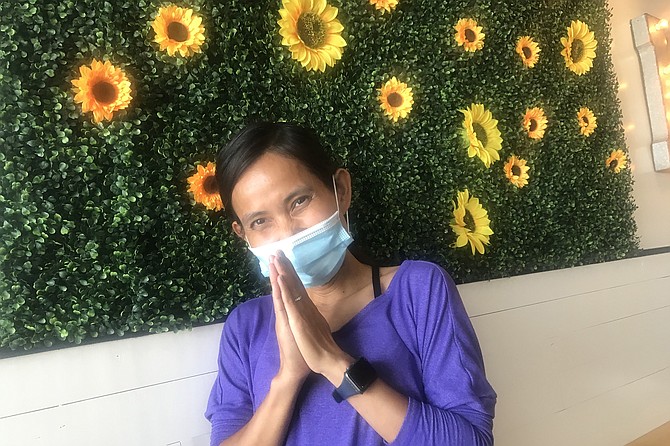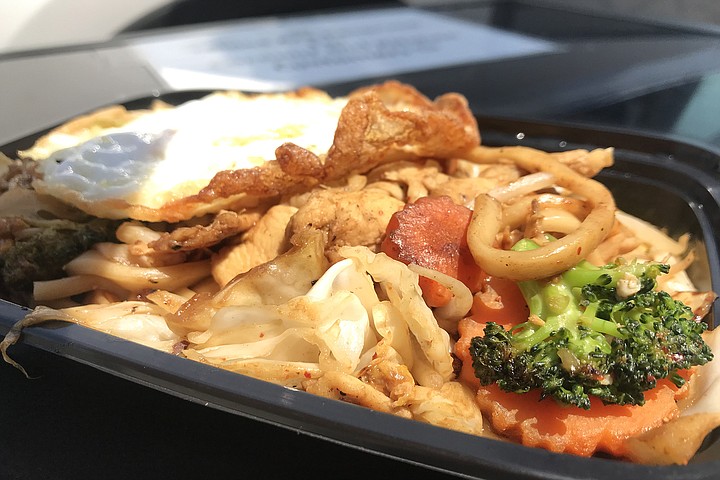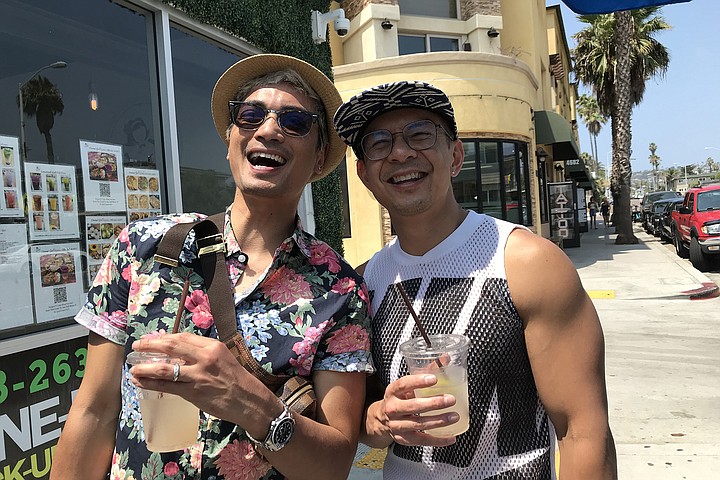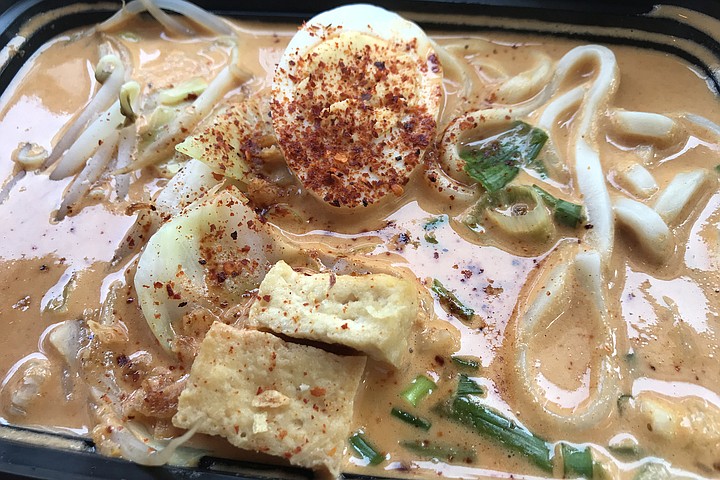 Facebook
Facebook
 X
X
 Instagram
Instagram
 TikTok
TikTok
 Youtube
Youtube

“Malaysian?” asks Kevin.
We’re standing outside this little storefront place. It’s like so many others here on Mission Boulevard: small, quirky businesses, many from the ’50s, most of them appealing to the surf culture. Except this one is Malaysian. Somehow you don’t think “surf” and “Malaysia” in the same breath. Which is crazy, because Malaysia has some of the best surf and most incredible beaches and unbelievable islands in the world.
“Yeah, but Malaysian food?” I reply. “I’m honestly trying to remember what that would be like.”
I should know. I’ve been to Thailand, and hey, that’s just north of Malaysia. I know Malaysia is a Muslim country, which kinda influences the food they eat. And I know that Thailand’s “Gang Massaman” comes from the south, near Malaysia. It means “Muslim curry.” And it’s totally delish. But that’s about all I got.

“We’ve just eaten a whole lot,” says this guy Ernie. He and his friend Carlito are finishing up at one of the sidewalk tables outside the place, which is called Coconut Girl Kitchen. “We had shumai, open-faced dumplings. And others as well. It’s street food. They’re such a good price here.”
Now Kevin starts reminiscing about Lau Pa Sat, a famous hawker food center in Singapore. “I had laksa,” he says, “every night I was there. It was addictive.”
Laksa? “Here,” says Ernie. He’s pointing to the menu in the window. “‘Laksa, curry noodle soup with bean sprouts, cabbage, hard-boiled egg, crispy onions, fried tofu.’” Costs $10.50, plus $3 if you want chicken in there.
“I loved all the dumplings,” adds Carlito. “We had a lot of them, including hargow.” (“Shrimp bonnet” dumplings, usually stuffed with mutton, scallions and ginger.)
Sounds good, even though I don’t pretend to know much about the almost cultish world of dumplings. Besides, most dumplings come from the Mother Culture of China, and I’m looking for Malaysian accents. So Kevin and I head on into this plain (but still attractive) space with its artificial grass and flowers on both side walls, and a large bulb-illuminated sign that says “Kitchen.” Rachel the cashier hands out menus, and we study them like they’re exam papers. Seeing lots of Thai dishes, quite a few Chinese dishes, only one or two that say they’re from Malaysia.

“So who are the Malaysians?” I ask. Because Kevin has been there more than I have. “Like, where does their food come from?”
“Think Malays, Chinese, Indians, all living and eating and cooking together,” says Kevin. “Well, more or less. A mix, just like the US.”
So we’re looking, umming and ahhing,
There are a lot of cheap but attractive-sounding appetizers, things like crab rangoon ($6.25), dirty wontons (with seasoned chicken, topped with cheese, $6.95), and roti puffs ($5.95). And hey hey! They’re described as “Malaysian pancake puffs, with yellow curry dip.” Crushed peanuts and green onions on top. “Oh yeah!” exclaims Kevin. “Roti. They’re like croissants that you dip in a curry bath. Here, let’s get that, and I’ll decide the rest. Trust me, you’ll like it.” Okay, the guy’s an ex-Marine. Gets impatient. And he has been out in that area; I’ll give him that. Leave him to it.
“As long as it’s Malaysian. I want Malaysian food,” I say.
And soon enough, those roti puffs arrive. They are indeed like super-light croissants. And yes, you take one (there are half a dozen of them) and dip it in a bowl of yellow curry. The curry and the roti are surprisingly light, but still a perfect intro to this corner of the culinary world. Because that’s what these Malaysian dishes are: mostly curry-based. The laksa is one of the biggies. It has tummy-stretching amounts of veggies and meat in it. It’s colored almost red, and, well, tastes to me like sweet panang, the Thai curry. Maybe a bit fishier in flavor. They say that because the dish has traveled up and down the Silk Road, laksa has gathered 10,000 tastes. And guess what? “Laksa” in ancient Sanskrit means “ten thousand.”

But the clincher (cruncher?) has to be mi goreng (fried noodles, $10.50). It’s Malaysian-style stir-fried udon noodles, with cabbage, carrots, green onions, broccoli, a fried egg (for two bucks more), bean sprouts, and your choice of meat. And the Japanese were right: there’s something about the wide, slow, fat udon noodle that is comforting. That’s why it’s beloved. It absorbs all the flavors around it. It feels like a cat curling its tail around your tongue. Eating it makes you contemplative. So by the time we’ve had our fill, we’ve split a ton of mi goreng. (When I get into it again, back at the ranch next day, I reheat, then add Sriracha for heat and soy to sharpen up the flavor. Result is like a fresh plateful.)
When I’m paying, I meet Supranee, the chef and part-owner. (“But everybody calls me ‘Tuk.’”) She is from the northeast of Thailand, but her restaurant partner is from Malaysia. She’s here partly because of covid. “I have a PhD in chemistry,” she says. “I interned at the Salk Institute, and then two things happened: I started having babies, and covid hit. We opened this restaurant a year ago — at the wrong time! — but people have been wonderful. We have survived, and I have still been able to experiment. Not in the lab, but with recipes. We’re always changing the menu. We’ll have a lot more dishes from Malaysia soon.”
I hope they do. Ain’t many restaurants that claim to make Malaysian food, and curries are growing on me. So hey, let’s keep this outpost — and Tuk, the Coconut Girl — alive and cookin’!


“Malaysian?” asks Kevin.
We’re standing outside this little storefront place. It’s like so many others here on Mission Boulevard: small, quirky businesses, many from the ’50s, most of them appealing to the surf culture. Except this one is Malaysian. Somehow you don’t think “surf” and “Malaysia” in the same breath. Which is crazy, because Malaysia has some of the best surf and most incredible beaches and unbelievable islands in the world.
“Yeah, but Malaysian food?” I reply. “I’m honestly trying to remember what that would be like.”
I should know. I’ve been to Thailand, and hey, that’s just north of Malaysia. I know Malaysia is a Muslim country, which kinda influences the food they eat. And I know that Thailand’s “Gang Massaman” comes from the south, near Malaysia. It means “Muslim curry.” And it’s totally delish. But that’s about all I got.

“We’ve just eaten a whole lot,” says this guy Ernie. He and his friend Carlito are finishing up at one of the sidewalk tables outside the place, which is called Coconut Girl Kitchen. “We had shumai, open-faced dumplings. And others as well. It’s street food. They’re such a good price here.”
Now Kevin starts reminiscing about Lau Pa Sat, a famous hawker food center in Singapore. “I had laksa,” he says, “every night I was there. It was addictive.”
Laksa? “Here,” says Ernie. He’s pointing to the menu in the window. “‘Laksa, curry noodle soup with bean sprouts, cabbage, hard-boiled egg, crispy onions, fried tofu.’” Costs $10.50, plus $3 if you want chicken in there.
“I loved all the dumplings,” adds Carlito. “We had a lot of them, including hargow.” (“Shrimp bonnet” dumplings, usually stuffed with mutton, scallions and ginger.)
Sounds good, even though I don’t pretend to know much about the almost cultish world of dumplings. Besides, most dumplings come from the Mother Culture of China, and I’m looking for Malaysian accents. So Kevin and I head on into this plain (but still attractive) space with its artificial grass and flowers on both side walls, and a large bulb-illuminated sign that says “Kitchen.” Rachel the cashier hands out menus, and we study them like they’re exam papers. Seeing lots of Thai dishes, quite a few Chinese dishes, only one or two that say they’re from Malaysia.

“So who are the Malaysians?” I ask. Because Kevin has been there more than I have. “Like, where does their food come from?”
“Think Malays, Chinese, Indians, all living and eating and cooking together,” says Kevin. “Well, more or less. A mix, just like the US.”
So we’re looking, umming and ahhing,
There are a lot of cheap but attractive-sounding appetizers, things like crab rangoon ($6.25), dirty wontons (with seasoned chicken, topped with cheese, $6.95), and roti puffs ($5.95). And hey hey! They’re described as “Malaysian pancake puffs, with yellow curry dip.” Crushed peanuts and green onions on top. “Oh yeah!” exclaims Kevin. “Roti. They’re like croissants that you dip in a curry bath. Here, let’s get that, and I’ll decide the rest. Trust me, you’ll like it.” Okay, the guy’s an ex-Marine. Gets impatient. And he has been out in that area; I’ll give him that. Leave him to it.
“As long as it’s Malaysian. I want Malaysian food,” I say.
And soon enough, those roti puffs arrive. They are indeed like super-light croissants. And yes, you take one (there are half a dozen of them) and dip it in a bowl of yellow curry. The curry and the roti are surprisingly light, but still a perfect intro to this corner of the culinary world. Because that’s what these Malaysian dishes are: mostly curry-based. The laksa is one of the biggies. It has tummy-stretching amounts of veggies and meat in it. It’s colored almost red, and, well, tastes to me like sweet panang, the Thai curry. Maybe a bit fishier in flavor. They say that because the dish has traveled up and down the Silk Road, laksa has gathered 10,000 tastes. And guess what? “Laksa” in ancient Sanskrit means “ten thousand.”

But the clincher (cruncher?) has to be mi goreng (fried noodles, $10.50). It’s Malaysian-style stir-fried udon noodles, with cabbage, carrots, green onions, broccoli, a fried egg (for two bucks more), bean sprouts, and your choice of meat. And the Japanese were right: there’s something about the wide, slow, fat udon noodle that is comforting. That’s why it’s beloved. It absorbs all the flavors around it. It feels like a cat curling its tail around your tongue. Eating it makes you contemplative. So by the time we’ve had our fill, we’ve split a ton of mi goreng. (When I get into it again, back at the ranch next day, I reheat, then add Sriracha for heat and soy to sharpen up the flavor. Result is like a fresh plateful.)
When I’m paying, I meet Supranee, the chef and part-owner. (“But everybody calls me ‘Tuk.’”) She is from the northeast of Thailand, but her restaurant partner is from Malaysia. She’s here partly because of covid. “I have a PhD in chemistry,” she says. “I interned at the Salk Institute, and then two things happened: I started having babies, and covid hit. We opened this restaurant a year ago — at the wrong time! — but people have been wonderful. We have survived, and I have still been able to experiment. Not in the lab, but with recipes. We’re always changing the menu. We’ll have a lot more dishes from Malaysia soon.”
I hope they do. Ain’t many restaurants that claim to make Malaysian food, and curries are growing on me. So hey, let’s keep this outpost — and Tuk, the Coconut Girl — alive and cookin’!